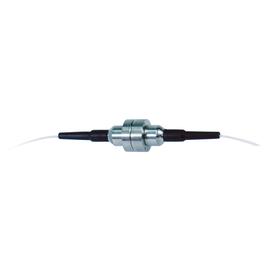Data and power transmission for rotating applications in industrial robots
Due to the digital interconnectivity of machines, systems, equipment and devices, enormous amounts of data accumulate in many industries. As a result, the requirements for data transmission quality, data rates and real-time capability of the bus systems in industrial robots are increasing.
Open kinematic chains with multi-dimensionally moving parts, e.g. multifunctional arms in robotics, or rotating elements such as rollers or axes, pose a particular challenge within the signal or data transmission path. Therefore, so-called rotary joints or rotary couplings are successfully implemented in end effectors, turning tables or for motion detectors for distance and object recognition of industrial robotics of production plants and production lines.
Contactless, capacitive transmission method with advantages over slip rings
The transmission of data or also power is often carried out by slip rings. The contactless, capacitive transmission method is preferably used in systems where rotating system parts have to fulfil deterministic tasks or where slip rings wear out quickly due to high speeds or fail after a short period of operation due to lack of reliability. The advantages of contactless transmission include
- 24 x 7 operation without downtime and costs due to repairs and maintenance while maintaining reliability (MTBF), long lifetime
- Operation without transmission errors due to micro-interruptions or line reflections
- Transmission rates of up to 1 Gbit/s with Ethernet-based bus systems possible even at very high speeds
- Supports all bus protocols based on IEEE802.3, such as Profinet IRT, Sercos III, Ethercat and Powerlink, Profibus 12 Mbit/s, CAN (repeater mode), RS 422 signals
- The bit error rate "BER" is less than 1x10-12 even at 99 percent bus utilization
- Automatic adaptation through auto negotiation with the Gigabit Ethernet coupler
- Error-free data transmission at up to 6000 rpm (optional) with operation independent of the direction of rotation
- Hollow shaft diameter up to max. 360 mm, interior of the hollow shafts remains completely free and can be used by the customer without restrictions
- Energy transmission with controlled output voltage possible independent of speed and direction of rotation, alone or in combination with data transmission. The output voltage is freely selectable within wide limits, contactless rotary transformers for 24 V DC are available up to 300 watts. When transmitting DC link voltages of up to 600 V DC, power of up to 11 kilowatts can be rotationally transmitted.
Data transmission with fiber optic rotary joints (FORJ)
If a user prefers data transmission by means of optical fibres, single-channel or also multi-channel rotary joints are available as an alternative for various signal transmission elements in end effectors, turning tables or for motion detectors for distance and object recognition of industrial robots. Optical fibre rotary joints from SPINNER can be operated without multiplexing, with up to 109 channels and all types of conductors (singlemode, multimode and conductors with thick-core fibres). They have minimal reflection losses, achieve high data speeds and are immune to EMI/EMC influences.











